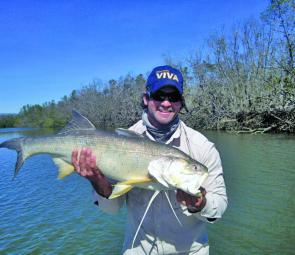By far the coolest and longest winter I’ve seen for a long time, but August generally dictates whether the warmer temperatures are on the way.
By the end of this month jumpers should be packed up and bread and butter species like winter bream, flathead and big whiting slowly fade away. But while the cooler days remain, so do the fish.
There’s a few landmark locations well worth a shot for these species and one of the best whiting hotspots has to be Cungulla, a small fishing township only 40 minutes south of Townsville. You can also get a full bucket of yabbies from the flats that make up this vast estuary that also hold some of the best barra fishing as well.
While pumping for yabbies check out the flats for unnatural holes of patches of divots in the mud and sand, these are first hand information that flathead have been lying here on the high tide. Flathead respond well to lures and a couple of lures that have worked for me over the years has to be the Koolabung blade and DOA prawn. These lures just seek and destroy any predator in its path!
While the flats will continue to hold good fish so too will the deeper reaches of the Haughton. Over the past month barra will still bite but only if a live prawn is nestled in the face of a hungry barra. Don’t expect them to move too far!
If luring is more your style then try soft plastics as the metabolism of all fish takes its time to acquire the taste of fish baits. Soft plastics can be weighted to suit the terrain you’re fishing and usually the slower, the better. Keep in mind to always match the hatch.
Soft plastics can be worked in a variety of locations, making them the best all rounder lure. Whether casting at snags or bouncing them off the bottom of a deep hole, their more natural presentation usually receives much more attention.
The barra are still feeding well and it has to be the most consistent year for barra all round. As the water warms up this month and leads us into my favourite month for barra, it still pays to put the time in as no one truly knows exactly when they spawn. It’s towards the end of August onwards until the closed season where we start to see monster fish caught on a regular occurrence.
But for now as the water still remains relatively cool look for shallow areas such as sandy or muddy flats and shallow creeks to find barra trying to find warmer water. Even one degree change in temperature can make all the difference!
August is still prime time for Spanish mackerel. By far the best way to target big Spaniards is using wolf herring rigged up on a chin guard. Areas like Cape Cleveland, 20ft, 4ft and Salamander reef will all hold good mackerel but keep on the move until you find them.
Another tip in finding fish is to keep an eye out for birds working the surface, as you never know what may lurk beneath.
With the mackerel bunching up at the shoals of late, it’s time to polish up the chrome metals and chase them one on one. To do this you need a few different sizes and colours of metals but most of all…a lot of them. Try avoiding using a wire trace and instead, adopting a thick mono leader as the bite rate will increase significantly.
Closer inshore the school mackerel have been in plague proportions and should hang around this month at areas like the Shipping Channel, Middle Reef, Pallarenda and West Point. For those land-based don’t be disgruntled as some good fish have been caught from the Strand jetty, rock pool and the end of the casino rockwall.
Unweighted pilchards on a ganged hook rarely miss, although small metals slices cast and worked at high speed at times will out fish any other method. While fishing this area it always pays to also work the rocks right below your feet, as hungry fish may be resting up as close as they can to the rocks in hope for some warmth from the winter sun.
Reads: 2973
August is a good time chase big Spaniards on metals, you may lose a few lures but the buzz is electric!

Derek had his hands full from the word go while fishing with Aussie Barra Charters recently.

Karim with a big threadfin salmon caught on a soft plastic during the cooler period.




